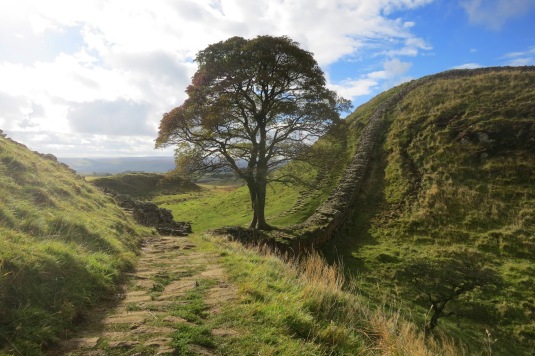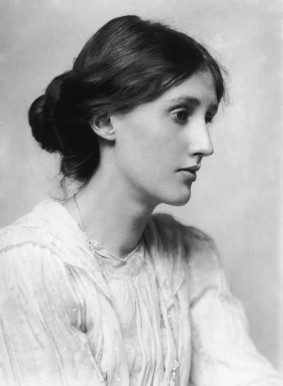‘You’re walking Hadrian’s Wall on your own?’ gasps the man, by way of greeting, as I’m met by him passing the mouth of a bunk house just off the farm track I’m walking. This theme of surprise, or of my heroic bravery which was so noteworthy that it required commentary, occurred three times whilst I completed a 90km walk on my own from Heddon-on-the Wall, Northumberland to Carlisle in Cumbria, in March 2016, the purpose being to take in the most finely preserved parts of Hardian’s Wall that I’d set my heart on doing a year earlier.
It was curious that these comments on my bravery or the extraordinary nature of my walk came from a variety of people. Once from this gasping winter hatted man with a teddy on his rucksack, I deduced he was walking the wall path for a children’s charity with what seemed to be a couple of others in his troupe, a large group of him and other walkers flocked out of the bunkhouse shortly after what must have been their breakfast.
Another comment came from a very matron-like bed and breakfast landlady who provided me with the funniest memories of my interactions with others along my walk. I remember her serving me tea in very posh china whilst I was sat, the only guest, in a communal living room surrounded by pictures of royal hunts, porcelain dolls and very grand clocks. She sat pouring me tea as I tried not to slouch and grimacing as I was very aware of my sweaty, muddy, (almost) blister proof socks on display on the rather nice carpet. She later tells me as I settle the bill for my dinner the night before that I’m ‘very brave’ for doing this walk on my own. She’d never do such a thing along she ponders as she wanders off to fetch my change.
Even a cheery chatty taxi driver notes, between telling me about what pubs might be open on the bank holiday for me to eat at, that it’s very often couples or groups that do the walk, I’m ‘very brave’.

Sycamore Gap, Hadrian’s Wall. One of the most iconic markers on the Hadrian’s Wall Path.
So here’s the important part that was all building up to – I cannot help but feel that I would not have heard such comments from the strangers I spoke with had I been a young twenty-something male travelling alone on this adventure. I truly believe the comments stem from the fact that I am a woman firstly, and secondly because of the nature of solitude with which I chose to do this walk.
Reflecting on the comments from the three individuals gave me elements that they all had in common, there was a mixture of surprise or what they perceived as an unusual-ness to what I did. This came out most from the winter hat man ‘it must get very quiet, just you walking it alone’ he puzzled at me before walking on, and the bed and breakfast landlady put herself in my position – I cannot imagine walking it alone, she reflects, despite her living room full of guidebooks to the Wall, her business relying on those travelling it and her reflections that she’d been there for short walks over the years there with her daughter. To be ‘brave’, surely is their reflection on that fact I’m doing something that is either not commonly done, or they perceive what I do as dangerous or odd in some manner.
It was 90km I walked following the Hadrian’s Wall Path National Trail and it was indeed a rather solitary 90km, 5 days of rising early, eating breakfast cooked by my landlord or landlady alone, walking alone, navigating alone, stopping off at pubs alone with a pint and chatting to strangers merrily when anyone seemed willing to talk. Shout out to a lovely Scotsman I met from West Lothian at the Robin Hood inn on Military Road on the first day of my walk whose name I’ll never know… I had a fantastic quality of conversation when strangers did speak to me, cashiers, bartenders, hosts, fellow walkers, photographers, elderly couples, families, but despite all this the walk’s defining feature was solitude and it is one of the reasons why I chose to do it.
A final noteworthy moment on the perceived peculiarity of what I did happened whilst I was sitting in the Twice Brewed Inn, in a tiny place called Once Brewed in Northumberland after walking what is widely regarded as the most breath-taking sections of the Wall. After the steep ups and downs I was certainly ready for a pint!
I was sopping wet and cold, there had been very heavy rains, chatter and hubbub were around in this busy pub, whilst there was other walkers as well as locals I attracted a bit of attention as I sat down on a faux fur stool dripping from head to toe. I ordered a pint and was sat writing postcards to family members, drinking and waiting for a ride to a farm I was staying at for the night. Somewhere behind me a family sat eating dinner, I heard a little girl ask someone what I was doing. There was obviously something about me, to this small child, which took her as strange or unusual that it was comment worthy in regards to her understanding of the world so far. ‘She’s on her holidays doing some walking and she’s writing to tell people all of the lovely things she’s seen’ said a man’s voice.

Twice Brewed Inn, Once Brewed. Northumberland.
It never occurred to me that I might find myself writing significantly a lot more than just a couple of postcards about not just what I’d seen on my walk but actually about what it taught me about what are still very ingrained views on the immense ‘bravery’ and peculiarity of women travelling alone, particularly when it’s of an outdoors type nature, and also what I believe underlies that thinking which is an understanding of a woman choosing solitude as unconventional or comment worthy or at least – we can press on to conclude – that it is not regarded with the same avidly written about romanticism that male solitude stirs up.
You need only to look to figures like Christopher McCandles, also known as ‘Alexander Supertramp’, to see society’s devotion and worship to such male ‘pioneers’ of solitude and travel. Look at polymath Henry David Thoreau and you’ll see again a man who was an advocate of solitude and whose writing is widely admired.

Christopher McCandless (1968 – 1992) who inspired the film ‘Into the Wild’ (2007) based on the book of the same name.
Female solitude, however, is simply not regarded with the same wide adoration from society or when it is then it is done in a way that does not upset the status quo. I’ll give you an example of what I mean by that – as I wrote this blog I searched the internet for other women writing on this topic of female solitude or solo travel and I found an article explaining why men should date women who enjoy solitude.
What that article is doing is legitimising female solitude because it makes a woman better for dating. It does not legitimise and praise female solitude for its own sake, as a means to its own end. It does not legitimate female solitude as an opportunity and a freedom for women to think, to be creative, and to have the space to define herself only by her own mind and her mind alone. In this article female solitude is just another trait for her to appeal to men. It is limited, in this article, as a solitude that will never ever free her from social responsibilities or expectations but rather female solitude is trivialised as a cute little quirk, a shallow thing with no grand outcomes or ambitions which stem form it. What’s worse is that the article seems to have been written by a woman. Just like two of the three individuals who commented on the peculiarity of my walk were other women. Replication of ideas that limit women are not just from men, they are ideas that have proliferated all through society and sometimes come equally from the mouths of other women.
That was a look at female solitude as praised but in a way that actually undermines female solitude and its worth. What we really need to look at is still a wide spread misbalance of a huge amount of respect and admiration for male solitude in comparison to women’s solitude.
I pondered this and could think only of A Room of One’s Own by Virginia Woolf when I tried to think of a piece of writing which really did honestly praise women’s solitude and the independence that comes with it. For those that have never read this famous text by Woolf, I highly recommend it, it was born out of a talk she did for Newnham College and Girton College, two women’s colleges at Cambridge University where she was invited to talk about women and fiction in 1928. She decided to write this into an extended essay about the conditions under which women are most capable and free to do creative work. It’s a text about women’s independence and autonomy.
A final pointer to the great difference between how female solitude is perceived and male solitude is still to look closer at Virginia Woolf. Any discussion of Woolf’s writing is always accompanied by a discussion of the context of her mental health problems and her own solitude, amongst other writings her Diaries are well regarded, she spent hours every day completing entries. Woolf’s own solitude and the outstanding pieces of literature she created out of it are often undermined by her mental health problems which led to her suicide in 1941. She fits a widely used trope of uncommon plagued solitary female genius. She is used to cement an image of female solitude as a failing of a woman, an irregularity, an oddity, even female solitude as synonymous with mental health problems. Female solitude is often used to undermine women rather than admire them. Male independence good. Female independence bad. Male independence healthy. Female independence unhealthy and dangerous, oh and not to mention odd.

Virginia Woolf, authored ‘A Room of One’s Own’ explaining the importance of a woman’s independence and solitude as necessary for creative work.
I was asked a couple of times by friends and a family member at the time why I was walking on my own, ‘did my friends not want to come? Why didn’t I ask my friends?’ These questions I think probably had an element of pity in their tone, again, as if I had failed in something.
To do the walk on my own, to come home, to write and reflect on the walk and what it taught me is a challenging act. It seeks to normalise women’s solitude and solo travel in a way that is not the adventures of a ‘loner’ which has somehow taken on a derogatory meaning which I despise, but as an extremely powerful thing. It challenges this concept of ‘bravery’ around women’s independence in travelling which upholds an idea that women’s solitude and solo travel is not expected or the norm.
In all of this I am grateful above all else, not all women have the economic freedom to travel alone, to travel at all, or to take holiday from the day’s work and just go. But if women do then it’s important that we continue to revel in it as an act, writer about it, speak about it, share it, and challenge an image of female solitude as negative, or a failing, or a freak oddity which will create a creative genius. Female solitude is still very powerful (and unnerving for some), all genders alike.

You’ve really nailed this on the head. I choose to go hill walking alone, because I simply enjoy it more on my own. I get comments from my friends and people I work with ranging from pity, through concern and amazement, to open disapproval. I very much doubt I’d experience anything of the sort if I were a male choosing to walk alone. I’ve never understood why people accept and admire male solitude as something verging on noble, while it’s seen as a freakish thing for a woman. I continue to do it, and talk about it (and defend it), as often as I can.
I’m glad you’ve written this blog!
Carrie